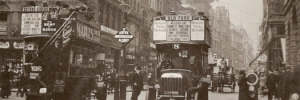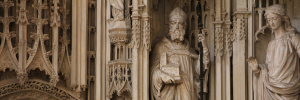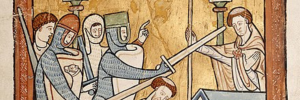Last week, Cubitts Opticians celebrated the opening of their new City of London store with a private tour of the local area for their staff.
Private tours in the evening add a wonderful sense of drama to the events. Part of the Roman London wall route originally taken by the northern wall is commemorated, although now only loosely followed, by the road also named London Wall. With the store having a London Wall address I would have been remiss to not have mentioned it.
This alignment, however, is the result of rebuilding between 1957 and 1976. Before this, London Wall was narrower, and ran behind the line of the City Wall for its entire length, from Wormwood Street to Wood Street. The western section is now St Alphage Garden which was our next stop. (see main pic).
St Alphage Priory Ruins
Originally, St Alphage was wedged right into the Roman London Wall, hence the name. The earliest mention of a church on this spot is impressive. It goes back to the 1100s but was closed by act of Parliament in in the late 1500s due to the Dissolution of the Monasteries.
The church buildings were renovated in the 1770s. The c.12th priory was rebuilt with a larger tower and the walls we can see are the base of that tower. The church tower survived when the nave was demolished in 1923 where the area was decimated by bombing during both world wars. Today only the base of that tower remains, dating from the c.14th can be seen. At night the ruins are lit up and look fabulous.
During the 1960s developers focused their energies on enabling people to walk through the city on raised walkways, up and above traffic level. But these were never popular. Now they have been reinvented and create an interesting walkthrough a strangely beguiling area. Directly behind the church ruins, a new hall for the Salters’ Livery Company was built in 1976. Today the gardens are part of that hall, but open to the public.
Salters Hall
The importance of salt, especially hundreds of years ago, cannot be overstated. Without salt, food would have been unpalatable and sometimes, if gold was not available, salt became the accepted token of exchange. If you look on their crest you can see some rather ornate salt shakers.
Barbican Estate
The Barbican Complex is a prominent example of British brutalist architecture and is Grade II listed as a whole. It was developed from designs by architects Chamberlin, Powell and Bon as part of a utopian vision to transform an area of London left devastated by bombing during the Second World War.
The word barbican comes from the Low Latin word Barbecana which referred to a fortified outpost or gateway, such as an outer defence of a city or castle or any tower situated over a gate or bridge which was used for defence purposes. In this case there seems to have been a Roman specula or watchtower.
Surprisingly the Barbican was also used to represent the MI6 headquarters in the James Bond film Quantum of Solace.
The Honourable Artillery Company
The Honourable Artillery Company is the oldest regiment in the British Army and the second most senior unit of the Army Reserve. The Company traditionally traces its origins to 1537 when Henry VIII granted a charter to the “Fraternity or Guild of Artillery of Longbows, Crossbows and Handguns”, which was also to be a perpetual fraternity of St George.
There are plenty of surprising film locations hidden around Moorgate too. Book your own private tour and find out yourself!
–
Hazel Baker is a qualified CIGA Tour Guide who delivers guided walks and private tours in London. View all of Hazel’s walking tours.



